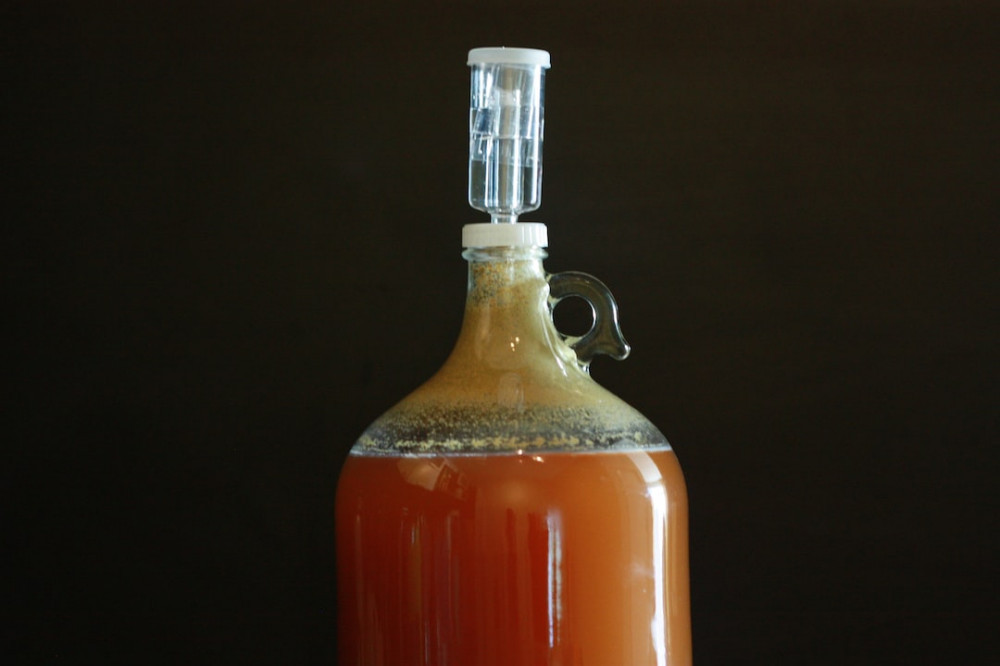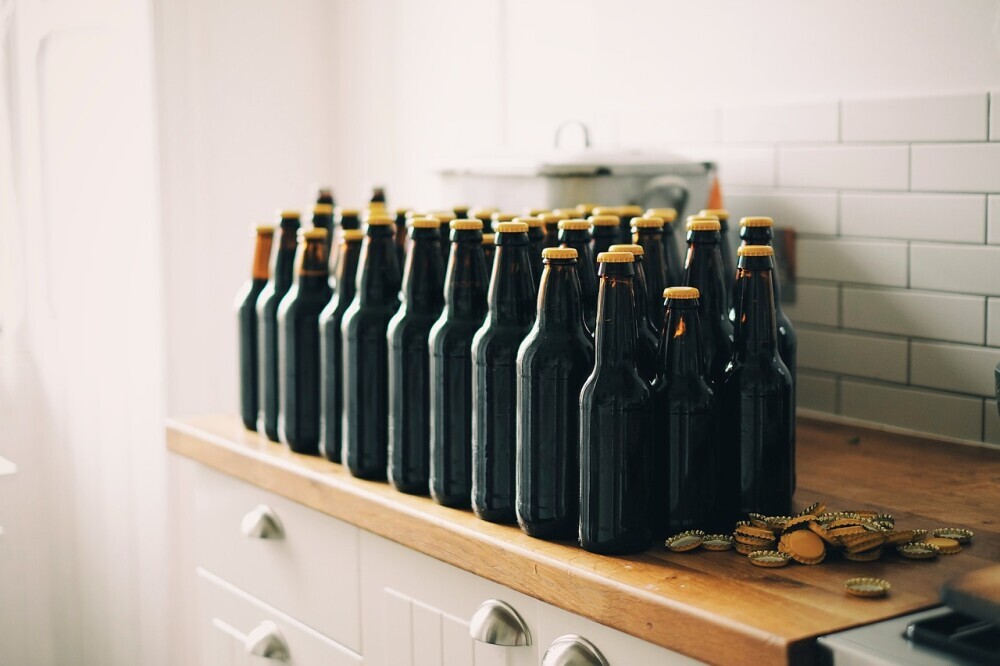.jpg)
Tired of spending too much on beer?
Don’t worry!
Brewing beer at home is actually quite easy.
Just follow the instructions and you’ll soon be enjoying your very own home-made beer – no kit needed!
Read this article and discover how to make a delicious beer at home.
The basics of brewing beer
Brewing beer at home is a hobby many enthusiasts enjoy!
Create unique flavors and experience the satisfaction of making something from scratch.
Beginners and experienced brewers alike need to understand the basics.
You’ll need ingredients and equipment.
Start with malt extract, liquid or powder. It provides sugars for fermentation.
Then, pick your hops for bitterness and aroma. Yeast is essential, it changes sugar into alcohol.
Once you have your ingredients, sanitize equipment to avoid contamination.
Heat water and stir in malt extract until dissolved.
Add hops for desired flavor profile.
Cool down mixture using an ice bath or wort chiller. T
his creates a good atmosphere for yeast activity.
Transfer the mixture (wort) into a fermentation vessel and pitch yeast.
Fermentation takes 1-2 weeks at controlled temperatures.
Yeast eats sugar and produces alcohol with carbon dioxide as a by-product.
When fermentation is done, transfer beer into bottles/kegs for carbonation.
Now that you know the basics of brewing beer without a kit, time to be creative.
Experiment with different recipes and techniques.
Don’t be afraid to mix up ingredients or change them.
So why wait?
Join the vibrant community of home brewers and get started today!
The equipment you’ll need
Brewing your own beer at home can be a fun and satisfying experience – no fancy kit required. Here’s what you’ll need:
- A large stainless steel pot: Essential for boiling the ingredients and creating the wort, which will eventually become beer.
- A fermenter: Choose a food-grade plastic or glass vessel with an airtight lid. It should be big enough for several gallons.
- Airlock and stopper: These let carbon dioxide escape during fermentation while stopping air from entering the fermenter.
Now for the unique details:
- Thermometer: For monitoring temperature throughout the brewing process. Maintaining the right temp is crucial for yeast activity.
- Hydrometer: To measure the specific gravity of your beer and check alcohol content and fermentation progress.
- Auto-siphon: This device lets you transfer beer easily from one vessel to another without contaminants.
Pro Tip: Sanitize all your equipment before using it. Cleanliness is key for high-quality beer.
The brewing process: science and alcohol unite – and your kitchen turns into a lab!
The brewing process
Brewing is an art form. Skill and knowledge are needed to create the perfect brew. Let’s explore the process with a table.
StageDescriptionDurationMashingMix grains with hot water. Convert starches into sugars.1 hourLauteringSeparate the pre-ferment beer from grain.2 hoursBoilingBring wort to a vigorous boil. Add hops for bitterness and flavor.1 hourFermentationYeast converts sugar to alcohol and carbonation.Few days to weeksConditioningAge the beer for flavor and clarity.Weeks to months
Different grains can be used in brewing, like barley, wheat, corn, rice, and rye. Each grain adds its own flavor and characteristics. Hops add bitterness and act as a preservative. Brewers choose hops based on aroma and flavor.
Brewing has been around for thousands of years. Ancient Sumerians and Egyptians brewed rudimentary beer. Now, brewing is much more sophisticated.
Brewing is messy, but it has a tasty result!
Fermenting your beer
Fermenting your beer is a must when brewing at home.
It helps to turn sugars into alcohol, giving your beer its unique flavor and aroma.
To make sure fermentation is successful, create an environment that encourages yeast growth and discourages bacteria.
To better understand fermentation, check out this table:
Fermentation TemperatureIdeal Range (°F)Ideal Range (°C)Ale68-7220-22Lager45-557-13Lambic60-7015-21
Keep the temperature consistent within the ideal range, to get the desired flavor and characteristics.
Apart from temperature, there are other factors that can affect fermentation.
Minimize oxygen exposure by using an airlock or a tight-fitting lid on your fermenter.
Yeast nutrients can also be added to increase yeast health and activity.
Patience is key when fermenting.
The length of fermentation depends on the type of beer, yeast strain, and temperature.
Don’t rush this process, as it affects the quality of the beer.
Follow these tips to ensure your homebrewed beer turns out great.
Pop open a cold one and cheers to your brewing adventures!
Bottling and storing your beer

Bottling and storing beer is an important part of homebrewing. Here are 6 steps to make sure your beer stays fresh and carbonated:
- Sanitize bottles.
- Keep equipment clean.
- Add priming sugar or carbonation tablet to each bottle.
- Fill bottles carefully, leaving headspace.
- Crown cap using a capping tool.
- Store in a cool, dark place.
Make sure storage temperatures remain consistent.
The art of preserving beer has been around for centuries.
Ancient Egyptians stored their beer in clay pots with wax seals!
If life gives you hops and barley, savor the taste of victory without spilling it.
Enjoying your homemade beer
Homemade beer can be a truly delightful experience. Here’s 4 key things to think about:
- Temperature: Keep your beer at the correct temp for the best taste and smell.
- Glassware: Use the right glass for each beer style; it really boosts the joy of drinking.
- Pairings: Try different foods with your beer – the perfect combo can bring out the flavor.
- Sharing: Invite people to share your creation. Build community and celebrate!
Plus, homemade beer has unique characteristics and flavors you can’t get from store-bought beer.
There’s a story in every batch, made with love and care.
Get creative – explore brewing techniques and ingredients to make something that’s truly yours.
Now let’s explore this further, with a story of homemade beer joy.
Get ready to brew something amazing. You don’t need a kit – you’re the mad scientist of fermentation!
Troubleshooting common problems
Troubleshooting is key to home brewing. Here are some pro tips:
- Sanitation: Clean and sanitize your equipment to avoid contamination.
- Fermentation: Keep your beer at the ideal temperature for proper yeast activity.
- Carbonation: Make sure you added the right amount of priming sugar during bottling.
Also, pay attention to the quality of ingredients. High-grade malt, hops, and yeast make a big difference.
Did you know that brewing dates back to 7000 BC? Ancient Mesopotamians used to ferment barley into beer. This craft has been passed down through generations – now we can enjoy making beer ourselves!
For a great brew, dig deep into beer brewing resources. One-liners won’t cut it.
Further reading and resources
If you’re keen to delve into homebrewing, there are lots of useful resources to take advantage of! Engage with experienced brewers on online forums, consult reputable books and magazines, watch instructional
YouTube tutorials, or visit local brew supply stores for personalized advice.
Consider joining a homebrew club for access to events, tastings, and competitions.
Additionally, to really enhance your learning experience, take notes while reading or watching videos, create a personal recipe journal, experiment with different ingredients, and seek feedback from others.
By using these resources, you’ll be able to create yummy beers that are uniquely yours! Cheers to your brewing journey!
FAQ
Can I brew beer at home without using a kit?
Yes, it is possible to brew beer at home without using a kit. You can gather the necessary ingredients and equipment separately.
What ingredients are needed to brew beer at home without a kit?
To brew beer without a kit, you will need malt extract, hops, yeast, water, and optional flavorings such as fruits or spices.
What equipment is necessary for brewing beer at home without a kit?
The basic equipment needed includes a large pot for brewing, a fermenter with an airlock, a thermometer, a siphoning tube, bottles or kegs for storage, and a hydrometer to measure gravity.
How long does it take to brew beer at home without a kit?
The brewing process typically takes around 4-6 weeks. This includes fermentation, bottling, and conditioning periods.
Are there any special precautions or sanitation measures required?
Yes, it is important to maintain a clean and sanitized brewing environment. This helps prevent contamination and ensures the quality of the beer.
Can I customize the flavor and style of beer brewed at home without a kit?
Absolutely! Brewing beer without a kit allows for complete customization. You can experiment with different ingredients and techniques to create unique flavors and styles.





Leave a Reply